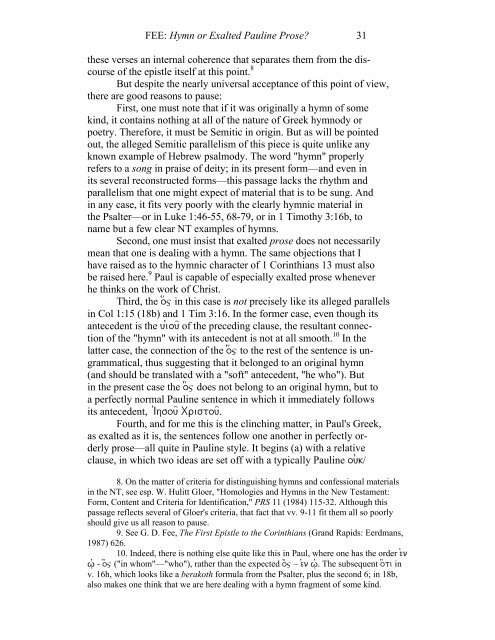Philippians 2:5-11: Hymn or Exalted Pauline Prose? - Institute for ...
Philippians 2:5-11: Hymn or Exalted Pauline Prose? - Institute for ...
Philippians 2:5-11: Hymn or Exalted Pauline Prose? - Institute for ...
Create successful ePaper yourself
Turn your PDF publications into a flip-book with our unique Google optimized e-Paper software.
FEE: <strong>Hymn</strong> <strong>or</strong> <strong>Exalted</strong> <strong>Pauline</strong> <strong>Prose</strong>? 31<br />
these verses an internal coherence that separates them from the discourse<br />
of the epistle itself at this point. 8<br />
But despite the nearly universal acceptance of this point of view,<br />
there are good reasons to pause:<br />
First, one must note that if it was <strong>or</strong>iginally a hymn of some<br />
kind, it contains nothing at all of the nature of Greek hymnody <strong>or</strong><br />
poetry. Theref<strong>or</strong>e, it must be Semitic in <strong>or</strong>igin. But as will be pointed<br />
out, the alleged Semitic parallelism of this piece is quite unlike any<br />
known example of Hebrew psalmody. The w<strong>or</strong>d "hymn" properly<br />
refers to a song in praise of deity; in its present f<strong>or</strong>m—and even in<br />
its several reconstructed f<strong>or</strong>ms—this passage lacks the rhythm and<br />
parallelism that one might expect of material that is to be sung. And<br />
in any case, it fits very po<strong>or</strong>ly with the clearly hymnic material in<br />
the Psalter—<strong>or</strong> in Luke 1:46-55, 68-79, <strong>or</strong> in 1 Timothy 3:16b, to<br />
name but a few clear NT examples of hymns.<br />
Second, one must insist that exalted prose does not necessarily<br />
mean that one is dealing with a hymn. The same objections that I<br />
have raised as to the hymnic character of 1 C<strong>or</strong>inthians 13 must also<br />
be raised here. 9 Paul is capable of especially exalted prose whenever<br />
he thinks on the w<strong>or</strong>k of Christ.<br />
Third, the o#j in this case is not precisely like its alleged parallels<br />
in Col 1:15 (18b) and 1 Tim 3:16. In the f<strong>or</strong>mer case, even though its<br />
antecedent is the ui(ou= of the preceding clause, the resultant connection<br />
of the "hymn" with its antecedent is not at all smooth. 10 In the<br />
latter case, the connection of the o#j to the rest of the sentence is ungrammatical,<br />
thus suggesting that it belonged to an <strong>or</strong>iginal hymn<br />
(and should be translated with a "soft" antecedent, "he who"). But<br />
in the present case the o#j does not belong to an <strong>or</strong>iginal hymn, but to<br />
a perfectly n<strong>or</strong>mal <strong>Pauline</strong> sentence in which it immediately follows<br />
its antecedent, I)hsou= Xristou=.<br />
Fourth, and f<strong>or</strong> me this is the clinching matter, in Paul's Greek,<br />
as exalted as it is, the sentences follow one another in perfectly <strong>or</strong>derly<br />
prose—all quite in <strong>Pauline</strong> style. It begins (a) with a relative<br />
clause, in which two ideas are set off with a typically <strong>Pauline</strong> ou)k/<br />
8. On the matter of criteria f<strong>or</strong> distinguishing hymns and confessional materials<br />
in the NT, see esp. W. Hulitt Gloer, "Homologies and <strong>Hymn</strong>s in the New Testament:<br />
F<strong>or</strong>m, Content and Criteria f<strong>or</strong> Identification," PRS <strong>11</strong> (1984) <strong>11</strong>5-32. Although this<br />
passage reflects several of Gloer's criteria, that fact that vv. 9-<strong>11</strong> fit them all so po<strong>or</strong>ly<br />
should give us all reason to pause.<br />
9. See G. D. Fee, The First Epistle to the C<strong>or</strong>inthians (Grand Rapids: Eerdmans,<br />
1987) 626.<br />
10. Indeed, there is nothing else quite like this in Paul, where one has the <strong>or</strong>der e)n<br />
w| ( - o#j ("in whom"—"who"), rather than the expected o!j – e)n w| (. The subsequent o#ti in<br />
v. 16h, which looks like a berakoth f<strong>or</strong>mula from the Psalter, plus the second 6; in 18b,<br />
also makes one think that we are here dealing with a hymn fragment of some kind.
















